Definition: Johari window is a psychological tool to self-assess one’s behaviour as well as the relationship with others, through feedback or disclosure. It is one of the most effective means of self-analysis by considering the other’s perspective to understand oneself in a better way.
It helps in determining the areas of expertise or strengths, the shortcomings, the scope of development and challenge to be faced.
Content: Johari Window
Johari Window Model
The Johari Window model was propounded by Joseph Luft and Harrington Ingham in the year 1955.
The model consists of four quadrants, each of which determines a different combination. These combinations are a result of facts known or unknown by oneself about himself along with the facts known or unknown to others.
To better understand this model, let us go through the following four possible combinations of the Johari Window Model: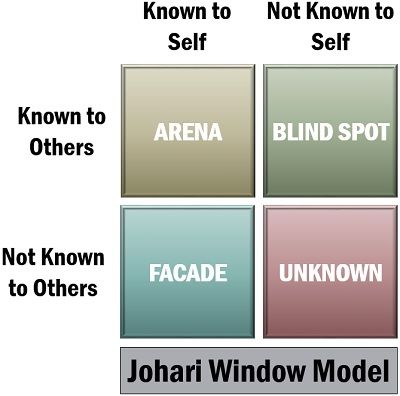
- Arena: The arena or open area represents everything which is made public or is commonly known oneself and to others too. It includes a person’s behaviour, attitude, skills, strengths, weaknesses, etc.
- Blind Spot: The area of talent or a specific trait or behaviour of a person which can be positive or negative, known to others; however, the person himself is unaware of it.
- Facade: It is a hidden area which is secretly known to the person alone, i.e. his feeling, emotions, ideas, etc., while others are unaware of it.
- Unknown Area: The area which remains undiscovered by the person himself or herself and also hidden from others, is termed as unknown areas. This area consists of new opportunities and scope for development along with threats and uncertainties.
Need for Johari Window
Johari window is one of the most useful tools for organizations to become successful and succeed over its competitors. To learn about its other advantages, read below: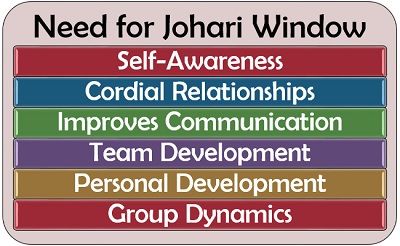
Self-Awareness: It acts as a self-analysis tool. Thus, making oneself aware of his strengths, weaknesses, opportunities and threats by considering the views of others too.
Cordial Relationships: It helps to improve the interpersonal relations since everyone gets to know each other in a better way and each focus on self-improvement.
Improves Communication: Johari window paves the way for open interaction and develops understanding among the managers and the subordinates.
Team Development: Strong team building is difficult if the team members are not familiar with each other. This model enhances the interpersonal relationship among the team members by making each familiar with the others in the team.
Personal Development: It provides scope for betterment since the blind area reveals those unknown facts which are known to others but may have been ignored by the individual himself. These facts are sometimes related to the individual’s attitude, habits, behaviour which needs to be mended.
Group Dynamics: The Johari window encourages open conversations and feedback within a group. This enhances group performance and develops a mutual understanding among the group members by eliminating the problem areas and misunderstandings.
Application of Johari Window in Business
Johari window serves as an essential tool to analyse the employees’ potential, work on organizational relations and improve team performance.
The other people associated with the business also contributes to organizational improvement and development. These are the financial institutions, shareholders, customers, suppliers, etc.
Taking into consideration the known and unknown facts by the company and the customers, the Johari window provides us with the four quadrants.
Let us see the various ways of modifying the business relations using this model:
Feedback to Reduce Blind Area
Taking constant feedbacks from the customers and knowing about the competitive products the consumers may prefer; makes the company aware of customer satisfaction level, product performance, consumer loyalty, level of competition, etc.
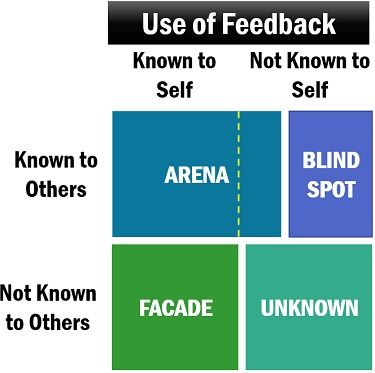 Being updated with the market trend and response diminishes the blind spot of the organization. It also increases the arena, as shown in the diagram above.
Being updated with the market trend and response diminishes the blind spot of the organization. It also increases the arena, as shown in the diagram above.
Move Out of Comfort Zone to Decrease Unknown Area
Innovation leads to learning and learning contributes to growth and development.
Therefore the organization must explore new possibilities or diversify into new products or means of production through proper research and development, to increase market share and profitability.
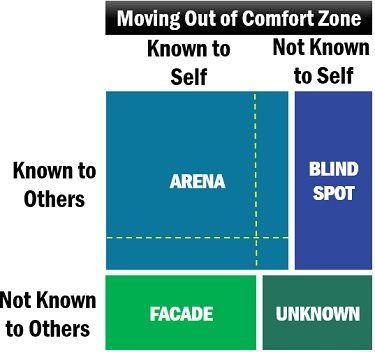 As seen above, exploring the untapped opportunities and developing new ideas can maximize the open area by diminishing the unknown region and shrinking the blind spot as well as the facade.
As seen above, exploring the untapped opportunities and developing new ideas can maximize the open area by diminishing the unknown region and shrinking the blind spot as well as the facade.
Disclosure to Reduce Hidden Area
At times, there are some strengths or positive traits of the product or the organization that is not much promoted. These may not be known to the customers creating a hidden area for the organization.
Therefore, the organization must reveal their strengths like the premium quality of raw materials used, the better shelf life of products, etc. to develop customer’s trust and loyalty.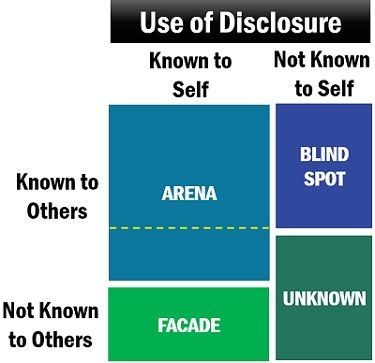 Going through the above diagram, we can say that disclosing the internal information can reduce the facade or the hidden area by expanding the arena.
Going through the above diagram, we can say that disclosing the internal information can reduce the facade or the hidden area by expanding the arena.
Example of Johari Window
To illustrate the concept of the Johari window model in a better way, let us go through the following example;
An organization employees new personnel ‘A’, seeing a specific skill set in him.
‘A’ being new to the company as well as to the team, is unfamiliar with people, organization and working. This leads to a shrunk arena and the blind area, whereas the hidden field and the unknown region is vast. Let us see its representation on the Johari window:
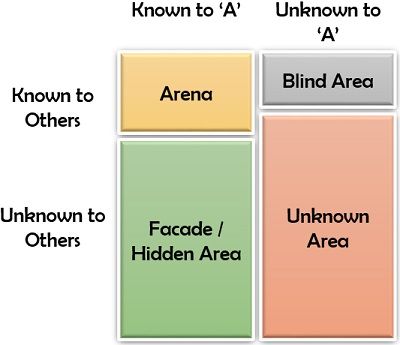
After a year, A becomes familiar to the organization and with each member of his team. He has managed to gather maximum information about his co-workers, and the company and the others now have a fair idea of his abilities, behaviour, skills and attitude.
This ultimately expands the arena or the open area, and decreases the hidden field as well as the unknown area as shown in the below Johari window:
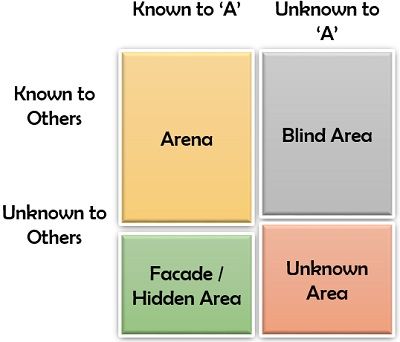
The above change in the Johari window of ‘A’ in one year shows that with constant interaction, regular feedback, cordial interpersonal relations, personal improvement increases transparency and develops trust among the employees.
Conclusion
As we know that all the four quadrants are unique but to maintain transparency and cordial relations within a team, it is essential to maximise the arena or the open area.
Thus, the Johari window aims at the improvement of interpersonal relationships, behaviour, attitude and skills within an organization by continually assessing the scope of growth.
Florence says
Great
Girish pati says
Nicely Described